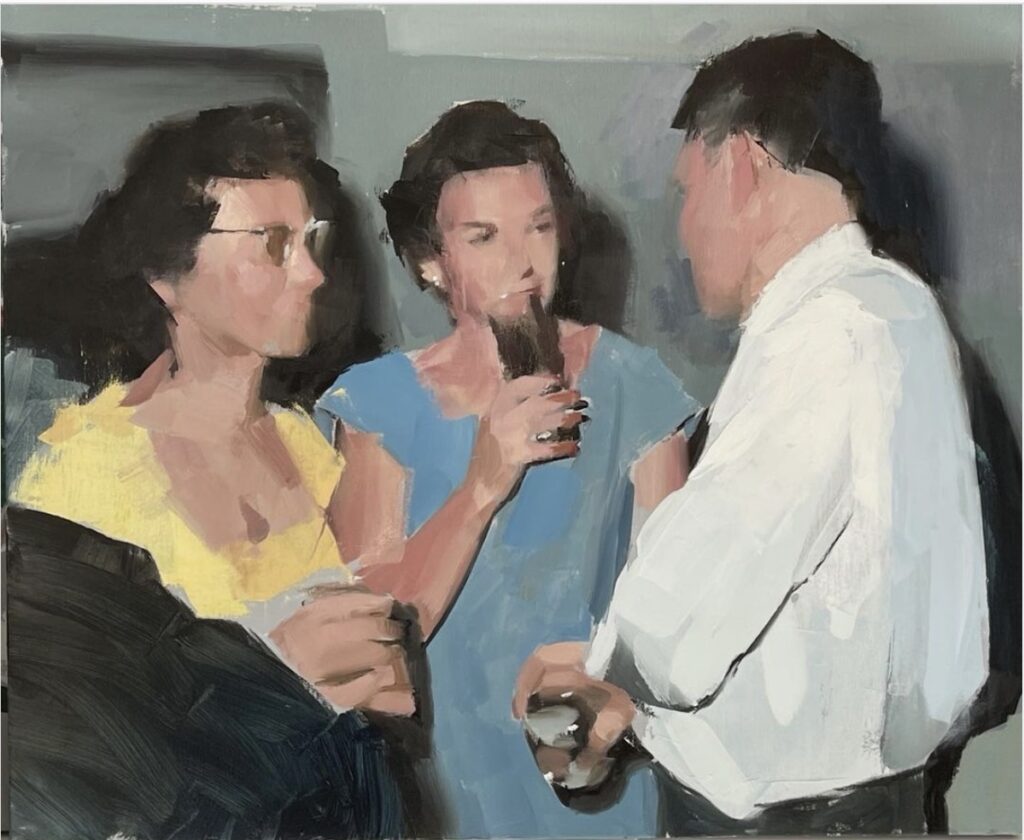Flash of genius

Mark Tennant, untitled from Instagram
Mark Tennant ought to be understood as one of the perceptual painters, but he doesn’t really adhere to any of the half dozen implicit rules the hardcore members of that group observe: the delicate balance between flatness and the illusion of depth; the preference for middle values, the slight fetish for letting one’s process show through a palimpsest effect that, for example, allows the viewer to see pencil lines through thin layers of paint or ghosts of earlier and abandoned shapes; their willingness to repeatedly rework a surface, groping toward a final resolution; a preference for middle values; and a general avoidance of photography. Tennant doesn’t adhere much to any of this, but his work shows random glimpses of mundane life in a way that works as both representation and almost gestural abstraction, which seems the prime directive for most perceptual painters. Tennant always works, it seems, from snapshots. His paintings seem intensely immediate and present—an impression of human motion frozen by an explosion of light. The work of the perceptual painters seems closer to the indeterminacy of memory, its slightly faded moodiness, than to the crisp detail of what greets the eye here and now. Tennant’s work oddly toggles between past and present, but it seems to make the past look contemporaneous, rather than the other way around. The look of a snapshot evokes the past, by definition, but what you see in one of his paintings seems alive and ready to move, something that caught your eye fifteen minutes ago. He loves the baleful glare of flash photography and the way it gives relief to figures, nudging them toward the viewer by coating them with dark outlines, penumbras of visible shadow that often seem, by some inexplicable leap, to hint at moral decline.
What’s so remarkable about his paint is the way it looks fresh, spontaneous, alla prima, and yet so astonishingly accurate—each little painting is like a visual haiku, the scene reduced to the fewest possible descriptive details, a face nothing but spots of color with three tiny marks to indicate eyes and nose, no need to even indicate a mouth. But nothing looks all that worked over: he’s giving you just what’s there, minus all the information you simply don’t need. That’s classic painting, but it feels, in his hands, like something fresh and unfamiliar. (And that’s great painting.) So simply executed, yet that little face of the woman in the center of her cocktail party chatter, that visage the size of a fingerprint, would be instantly recognizable to anyone who knew her, whoever she is. How is that possible? The eyes—like the tiny eyes in a very small El Greco I saw in New York years ago—convey a whole world of personality and experience, a soul. But Tennant has nothing else in common with the Greek. There’s no transcendence here, just that unforgiving flash of light and the darkness it only briefly penetrates. At first, his brushwork seems to descend from Matisse and Porter, looking loose and bold, everything quick as a sketch. But he’s intensely accurate, and his sensibility is brooding and ironic. His process may be much slower than it looks, so the painterly effect probably goes back more to Manet and Sargent, where you have a sense of mastery closer to Velasquez than the Impressionists, and they share Tennant’s vision of how metropolitan sophistication draws some of its energy from decadence. Matisse and Porter use color and tone for their own sake, presenting the joy of natural light just as it is, reaching out and embracing the world with love and appreciation; Tennant inhabits a spiritual world as distant from theirs as Alaska is from Africa. Perhaps what continues to awe me with the work he posts is how much it has evolved and crossed some kind of qualitative border late in his career into this recent mastery. Decades of work leading to the alchemy of this transformation after so much effort: Porter crossed that border too in his last decade. You can see something similar happening as well in the work of some other painters, like Stuart Shils, on Instagram. It’s marvelous.
Comments are currently closed.